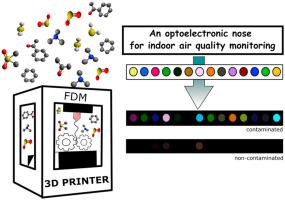当前位置:
X-MOL 学术
›
Anal. Chim. Acta
›
论文详情
Our official English website, www.x-mol.net, welcomes your
feedback! (Note: you will need to create a separate account there.)
Paper-based optoelectronic nose for identification of indoor air pollution caused by 3D printing thermoplastic filaments
Analytica Chimica Acta ( IF 5.7 ) Pub Date : 2021-01-01 , DOI: 10.1016/j.aca.2020.11.012 Naira Dias Pinheiro , Rafael Teixeira Freire , Josiele Aparecida M. Conrado , Alex Domingues Batista , João Flávio da Silveira Petruci
Analytica Chimica Acta ( IF 5.7 ) Pub Date : 2021-01-01 , DOI: 10.1016/j.aca.2020.11.012 Naira Dias Pinheiro , Rafael Teixeira Freire , Josiele Aparecida M. Conrado , Alex Domingues Batista , João Flávio da Silveira Petruci

|
Commercial printers based on fused deposition modeling (FDM) are widely adopted for 3D printing applications. This method consists of the heating of polymeric filaments over the melting point followed by their deposition onto a solid base to create the desirable 3D structure. Prior investigation using chromatographic techniques has shown that chemical compounds (e.g. VOCs), which can be harmful to users, are emitted during the printing process, producing adverse effects to human health and contributing to indoor air pollution. In this study, we present a simple, inexpensive and disposable paper-based optoelectronic nose (i.e. colorimetric sensor array) to identify the gaseous emission fingerprint of five different types of thermoplastic filaments (ABS, TPU, PETG, TRITAN and PLA) in the indoor environment. The optoelectronic nose is comprised of selected 15 dyes with different chemical properties deposited onto a microfluidic paper-based device with spots of 5 mm in diameter each. Digital images were obtained from an ordinary flatbed scanner, and the RGB information collected before and after air exposure was extracted by using an automated routine designed in MATLAB, in which the color changes provide a unique fingerprint for each filament in 5 min of printing. Reproducibility was obtained in the range of 2.5-10% (RSD). Hierarchical clustering analysis (HCA) and principal component analysis (PCA) were successfully employed, showing suitable discrimination of all studied filaments and the non-polluted air. Besides, air spiked with vapors of the most representative VOCs were analyzed by the optoelectronic nose and visually compared to each filament. The described study shows the potential of the paper-based optoelectronic nose to monitor possible hazard emissions from 3D printers.
中文翻译:

用于识别由 3D 打印热塑性长丝引起的室内空气污染的纸基光电鼻
基于熔融沉积建模 (FDM) 的商用打印机被广泛用于 3D 打印应用。该方法包括将聚合物长丝加热到熔点以上,然后将它们沉积到固体基底上以创建所需的 3D 结构。先前使用色谱技术的调查表明,在印刷过程中会排放出对用户有害的化合物(例如 VOC),对人体健康产生不利影响并导致室内空气污染。在这项研究中,我们提出了一种简单、廉价且一次性的纸质光电鼻(即比色传感器阵列)来识别室内五种不同类型的热塑性长丝(ABS、TPU、PETG、TRITAN 和 PLA)的气体发射指纹环境。光电鼻由选定的 15 种不同化学性质的染料组成,这些染料沉积在一个微流体纸基装置上,每个斑点直径为 5 毫米。从普通平板扫描仪获得数字图像,并使用 MATLAB 中设计的自动化程序提取空气暴露前后收集的 RGB 信息,其中颜色变化为每条灯丝在打印 5 分钟内提供了独特的指纹。重现性在 2.5-10% (RSD) 范围内。成功地采用了分层聚类分析 (HCA) 和主成分分析 (PCA),显示出对所有研究的细丝和未污染空气的适当区分。此外,通过光电鼻分析掺入最具代表性的挥发性有机化合物蒸气的空气,并在视觉上与每根灯丝进行比较。
更新日期:2021-01-01
中文翻译:

用于识别由 3D 打印热塑性长丝引起的室内空气污染的纸基光电鼻
基于熔融沉积建模 (FDM) 的商用打印机被广泛用于 3D 打印应用。该方法包括将聚合物长丝加热到熔点以上,然后将它们沉积到固体基底上以创建所需的 3D 结构。先前使用色谱技术的调查表明,在印刷过程中会排放出对用户有害的化合物(例如 VOC),对人体健康产生不利影响并导致室内空气污染。在这项研究中,我们提出了一种简单、廉价且一次性的纸质光电鼻(即比色传感器阵列)来识别室内五种不同类型的热塑性长丝(ABS、TPU、PETG、TRITAN 和 PLA)的气体发射指纹环境。光电鼻由选定的 15 种不同化学性质的染料组成,这些染料沉积在一个微流体纸基装置上,每个斑点直径为 5 毫米。从普通平板扫描仪获得数字图像,并使用 MATLAB 中设计的自动化程序提取空气暴露前后收集的 RGB 信息,其中颜色变化为每条灯丝在打印 5 分钟内提供了独特的指纹。重现性在 2.5-10% (RSD) 范围内。成功地采用了分层聚类分析 (HCA) 和主成分分析 (PCA),显示出对所有研究的细丝和未污染空气的适当区分。此外,通过光电鼻分析掺入最具代表性的挥发性有机化合物蒸气的空气,并在视觉上与每根灯丝进行比较。











































 京公网安备 11010802027423号
京公网安备 11010802027423号